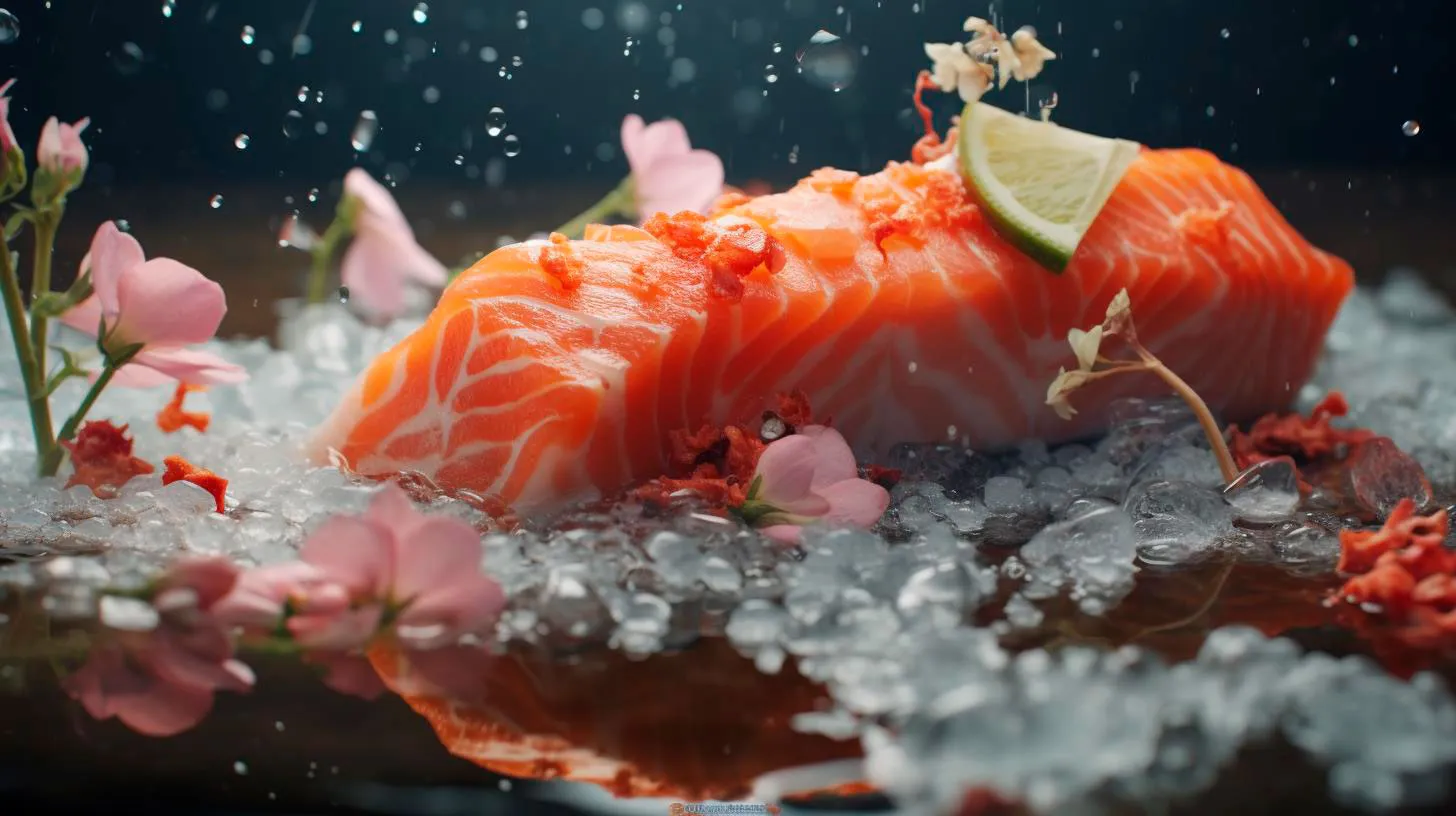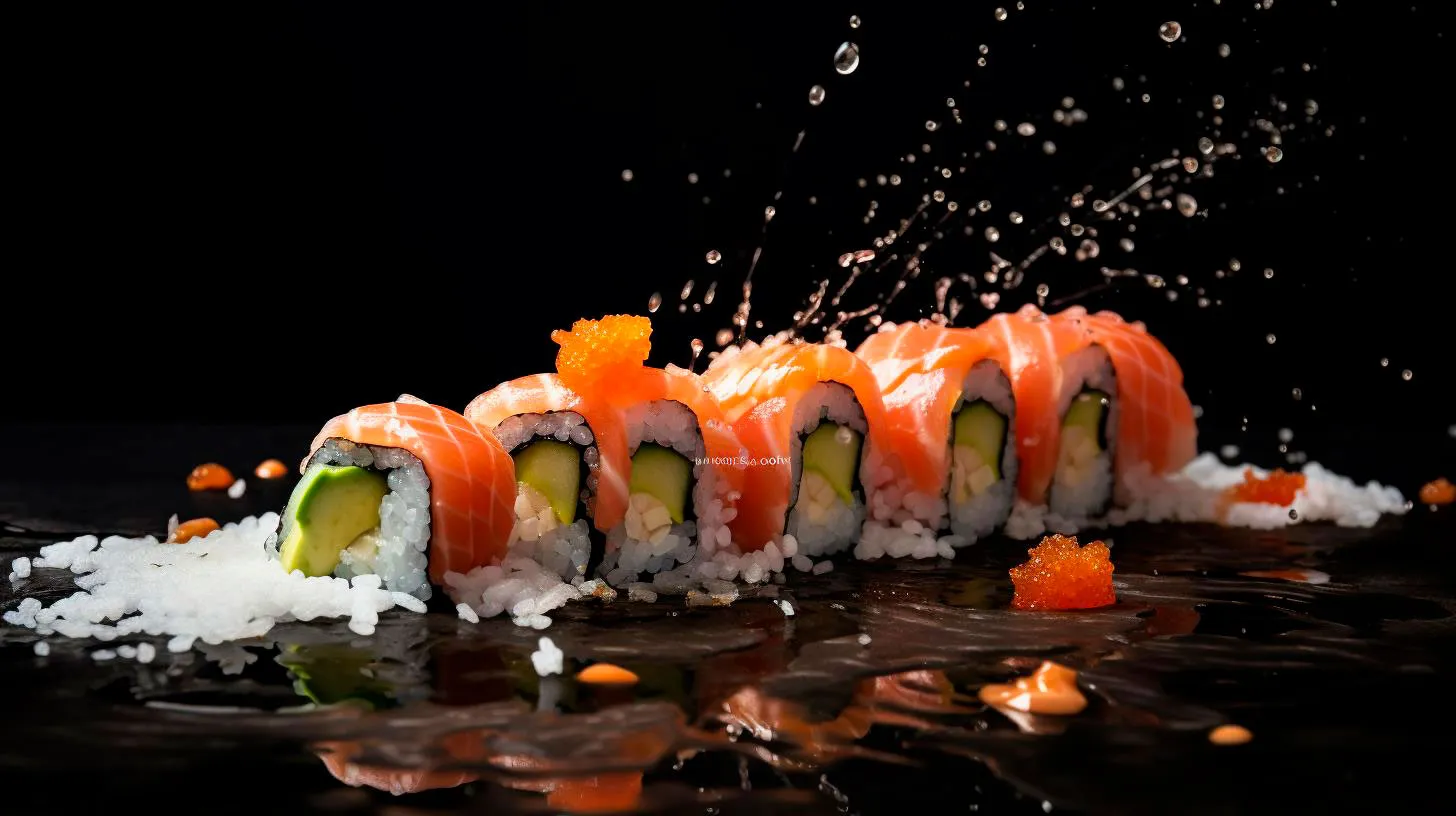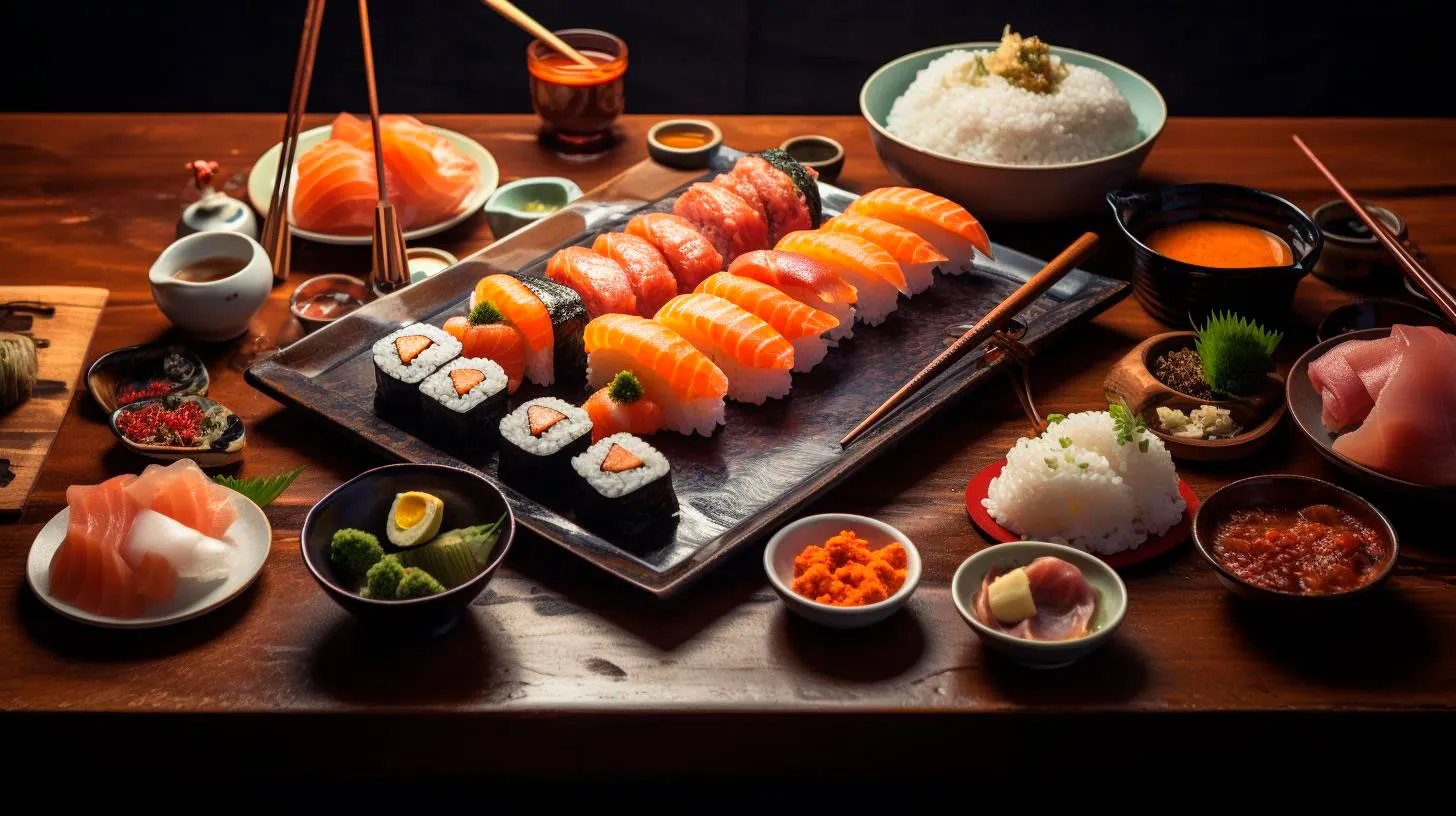Captivating Culinary Craftsmanship: Unveiling the Secrets Behind Traditional Sushi Presentation
In this article, we will unveil the secrets behind traditional sushi presentation and explore the captivating culinary world of sushi.
The Art of Traditional Sushi Presentation
Traditional sushi presentation is a visual feast that not only pleases the eyes but also enhances the overall dining experience. It involves various techniques, including:
- Nigiri: The most iconic form of sushi, nigiri consists of a slice of fresh fish or seafood draped over a mound of vinegared rice. The chef carefully shapes the rice to complement the flavor and texture of the fish.
- Maki: Maki rolls are cylindrical sushi rolls made by wrapping rice, fish, and other ingredients in a sheet of seaweed called nori. The rolls are then sliced into bite-sized pieces.
- Sashimi: Sashimi refers to thin slices of raw fish or seafood served without rice. The slices are delicately arranged on a plate to showcase the natural colors and textures of the ingredients.
- Gunkan: Gunkan sushi is characterized by a small piece of nori wrapped around a mound of rice, with various toppings such as roe, sea urchin, or other ingredients delicately placed on top.
Each sushi variety requires precision and creativity to achieve an aesthetically pleasing presentation. From the size and shape of the rice to the balance of flavors, every detail is meticulously considered.
The Importance of Freshness and Quality
When it comes to sushi, freshness and quality are paramount. High-grade ingredients are carefully selected to ensure the best flavor and texture. The fish must be incredibly fresh, preferably sourced from reputable suppliers or local fish markets. The rice, too, is essential and acts as the foundation of the sushi. The balance of flavors between the fish, rice, and other ingredients is crucial to creating a memorable dining experience.
Advantages of using fresh ingredients for sushi preparation:
- Enhances the flavors and textures
- Reduces the risk of foodborne illnesses
- Creates a more enjoyable dining experience
According to a survey conducted by the Japan External Trade Organization (JETRO), the global sushi market is expected to reach a value of $22.04 billion by 2023. This increase in demand highlights the importance of sourcing high-quality ingredients to meet the evolving expectations of sushi enthusiasts worldwide.
The Role of Presentation Techniques
Aside from the freshness and quality of the ingredients, presentation techniques play a significant role in traditional sushi. The carefully crafted presentation showcases the chef’s skill and attention to detail. Some essential presentation techniques include:
- Color coordination: The selection of ingredients aims to create an aesthetically pleasing color palette. Vibrant colors from fresh vegetables, fish, and garnishes are often combined to enhance the visual appeal of the sushi.
- Arrangement: Sushi is artfully arranged on the plate to highlight the beauty and texture of each ingredient. The chef carefully considers the balance of shapes, sizes, and textures to create a visually appealing composition.
- Garnishes: Delicate garnishes such as edible flowers, wasabi, and ginger are strategically placed to add a finishing touch to the presentation. These garnishes not only enhance the appearance of the sushi but also complement the flavors.
The result of these presentation techniques is not only visually stunning but also acts as a reflection of the chef’s expertise and creativity.
Key Takeaways
Traditional sushi presentation is a captivating culinary art form that showcases the meticulous craftsmanship and attention to detail of sushi chefs. Key takeaways from this article include:
- Sushi presentation involves various techniques, including nigiri, maki, sashimi, and gunkan.
- Freshness and quality of ingredients are crucial in creating exceptional sushi.
- Presentation techniques such as color coordination, arrangement, and garnishes play a significant role in showcasing the chef’s skill and creativity.
Next time you indulge in sushi, take a moment to appreciate the captivating culinary craftsmanship behind its presentation. It’s not just a meal; it’s an experience that combines art, taste, and culture.
Mastering the Art Masterclass in Traditional Sushi Presentation
In this blog article, we will explore the art masterclass in traditional sushi presentation, uncovering the key techniques, advantages, and takeaways that will elevate your sushi game to the next level.
The Importance of Traditional Sushi Presentation
Traditional sushi presentation not only adds aesthetic appeal to the dish but also plays a vital role in enhancing the dining experience. It is said that we eat with our eyes first, and the presentation of sushi sets the stage for the flavors and textures that follow. The art of sushi presentation respects the ingredients and their natural beauty, creating a harmonious and balanced visual display.
The delicate arrangement of sushi showcases the chef’s attention to detail, craftsmanship, and respect for the ingredients. The presentation can convey the essence of the dish, tell a story, and evoke a sense of anticipation in the diner. It elevates the entire dining experience, making it not just a meal but a sensory journey.
Masterclass Techniques for Traditional Sushi Presentation
To master the art of traditional sushi presentation, one must understand and practice various techniques that enhance the visual impact of the dish. Here are some essential techniques:
- Balance and Harmony: Achieving a balance between colors, textures, and flavors is key to a visually appealing sushi presentation. It is crucial to consider the combination of ingredients, their visual contrast, and the overall harmony of the sushi plate.
- Kansai-style Arrangement: This traditional sushi presentation style emphasizes simplicity and minimalism, allowing the natural flavors and textures of the ingredients to shine. The arrangement focuses on clean lines, symmetrical placement, and precise spacing.
- Garnishes and Accents: The strategic use of garnishes and accents can enhance the visual appeal of sushi. Common garnishes include daikon radish, shiso leaves, and edible flowers. Accents such as wasabi, soy sauce, and pickled ginger add additional flavors and visual interest to the dish.
Advantages and Key Takeaways
Mastering traditional sushi presentation techniques offers numerous advantages and key takeaways for both professional chefs and home cooks:
- Elevated Dining Experience: Exceptional sushi presentation transforms a meal into an unforgettable experience for diners.
- Cultural Appreciation: Traditional sushi presentation allows one to appreciate and showcase the cultural heritage and aesthetic values of Japan.
- Enhanced Culinary Skills: By learning and practicing sushi presentation techniques, chefs can enhance their overall culinary skills, attention to detail, and creativity.
- Increased Customer Satisfaction: For professional chefs, mastering sushi presentation techniques can lead to increased customer satisfaction and positive reviews.
The Growing Trend
According to recent industry statistics, sushi consumption is on the rise, with an increasing number of people seeking out traditional and authentic sushi experiences. With the growing interest in Japanese cuisine, sushi presentation has gained significant importance.
Restaurants that prioritize traditional sushi presentation and offer masterclasses or workshops on the art are experiencing a surge in popularity. Diners appreciate and seek out these authentic experiences, and the demand for skilled sushi chefs with expertise in presentation techniques is growing.
Whether you are a professional chef looking to refine your skills or an enthusiastic home cook eager to create visually stunning sushi, mastering the art masterclass in traditional sushi presentation is a worthwhile endeavor. Developing your techniques and experimenting with different sushi presentations will not only enhance the visual aspect of your sushi dishes but also elevate the overall dining experience for yourself and your guests.
Embrace the art of traditional sushi presentation, and let your creativity flourish!
Elevating Edible Art: Exploring the Aesthetics of Traditional Sushi Display
Today, we delve into the world of traditional sushi display, discussing its aesthetics, advantages, and key takeaways.

The Art of Traditional Sushi
The art of traditional sushi involves much more than simply preparing raw fish and rice. It is a meticulous process that incorporates centuries of refined techniques and cultural significance. One of the key components of sushi presentation is the display, which elevates the dining experience to an entirely new level. Let’s take a closer look at the aesthetics and elements that make sushi display a true work of art.
1. Harmony and Balance
Traditional sushi display emphasizes the principles of harmony and balance. Every element on the plate is carefully selected and placed to achieve an aesthetically pleasing composition. From the vibrant colors of the ingredients to the arrangement of sushi rolls, every detail is considered to create a visually appealing presentation.
2. Plateware and Utensils
Choosing the right plateware and utensils is crucial in sushi presentation. Clay plates, wooden trays, and lacquerware are commonly used to showcase sushi’s exquisite beauty. Delicate chopsticks and wooden serving spoons are carefully selected to match the overall theme and elevate the dining experience.
3. Textures and Patterns
Sushi display aims to create a visually stimulating experience through diverse textures and patterns. From the smooth texture of raw fish to the roughness of nori (seaweed), each ingredient adds a unique element to the overall aesthetics. Intricate patterns are often created using decorative ingredients like roe and thinly sliced vegetables, adding visual interest to the dish.
Advantages of Traditional Sushi Display
The meticulous artistry behind traditional sushi display brings a range of advantages to both diners and chefs. Let’s explore some of these advantages below:
- Enhanced Dining Experience: By incorporating aesthetic principles, traditional sushi display transforms a meal into a feast for the eyes as well as the palate.
- Cultural Appreciation: Sushi display provides a unique opportunity to appreciate Japanese culture and traditions, creating a memorable dining experience.
- Showcasing Ingredient Quality: Thoughtful presentation accentuates the freshness and quality of each ingredient, allowing diners to fully appreciate the premium components of sushi.
- Engagement and Interest: The intricacies of traditional sushi display capture the attention of diners, sparking curiosity and creating a memorable impression.
Key Takeaways
Understanding the art of traditional sushi display allows us to appreciate the skill and craftsmanship that goes into creating these edible masterpieces. Here are some key takeaways to remember:
- Harmony and balance are key elements in traditional sushi presentation.
- The choice of plateware and utensils plays a significant role in sushi display.
- Textures and patterns add visual interest to the overall aesthetics of sushi.
- Traditional sushi display enhances the dining experience and showcases ingredient quality.
Next time you indulge in a plate of sushi, take a moment to admire the artistry and craftsmanship behind its presentation. Traditional sushi display not only elevates the culinary experience but also serves as a beautiful representation of Japanese culture.
Rediscovering Tradition: Reviving Ancient Sushi Presentation Techniques
In this article, we will explore the ancient sushi presentation techniques and how they are making a comeback in the sushi scene.
The Art of Omakase
Omakase, a Japanese phrase that translates to “I’ll leave it up to you,” is a traditional dining experience where the chef personally selects and prepares each dish for the customer. This exclusive dining style allows the chef to showcase their skills and creativity while giving the customer a unique and personalized culinary journey.
In recent years, there has been a resurgence of interest in omakase-style sushi. Diners are now seeking authentic sushi experiences, where they can witness the chef’s mastery and attention to detail. This has led to a revival of ancient sushi presentation techniques.
Ancient Techniques Regaining Prominence
1. Gunkan-Maki: Gunkan-maki, also known as “battleship roll,” is a sushi presentation style that originated in the early 20th century. The technique involves wrapping a strip of nori (seaweed) around a rice ball and filling it with luxurious ingredients such as caviar, uni (sea urchin), or diced seafood. The result is a visually stunning dish that combines different textures and flavors.
2. Oshizushi: Oshizushi, or pressed sushi, dates back to the Edo period in Japan. The technique involves pressing layers of sushi rice and various toppings into a wooden mold called an oshibako. The chef then applies pressure to create a compact and beautifully patterned sushi block. Oshizushi allows for intricate designs and precise layering, making it a treat for both the eyes and the taste buds.
3. Chirashizushi: Chirashizushi, meaning “scattered sushi,” is a colorful and vibrant sushi dish that showcases a variety of toppings arranged on top of a bed of sushi rice. This ancient technique focuses on the presentation of various ingredients, including thinly sliced sashimi, pickled vegetables, and decorative garnishes. Chirashizushi offers a visually appealing and flavor-packed dining experience.
Advantages of Rediscovering Tradition
1. Preserving Culinary Heritage: By reviving ancient sushi presentation techniques, we pay homage to the rich culinary heritage of Japan. It allows us to connect with tradition and keep these valuable techniques alive for future generations.
2. Enhanced Dining Experience: Ancient sushi presentation techniques add an element of theatricality and beauty to the dining experience. The combination of visual appeal and taste creates a multi-sensory journey for sushi enthusiasts.
3. Showcasing Authenticity: In a world dominated by fusion cuisine and modern interpretations, traditional sushi presentation techniques help restaurants stand out by offering an authentic and unique experience for sushi lovers.
Key Takeaways
1. Omakase-style dining is witnessing a resurgence, with a focus on reviving traditional sushi presentation techniques.
2. Ancient techniques such as Gunkan-Maki, Oshizushi, and Chirashizushi are making a comeback, offering visually stunning and flavorful sushi dishes.
3. Rediscovering tradition helps preserve culinary heritage, enhances the dining experience, and showcases authenticity.
As sushi continues to captivate the world, rediscovering and reviving ancient sushi presentation techniques enables us to appreciate the artistry and complexity behind this cherished cuisine. By embracing tradition, we honor the past while creating unique and memorable experiences for sushi enthusiasts around the globe.
The Art of Authenticity: Traditional Sushi Presentation
Traditional sushi presentation is a visual feast that aims to stimulate not only the taste buds but also the eyes. It involves careful attention to detail, precise placement, and the use of vibrant and contrasting colors. The combination of these elements creates a visually pleasing display that is almost too beautiful to devour.
The Key Principles of Traditional Sushi Presentation
1. Balance and Symmetry: Each sushi plate is thoughtfully arranged to achieve a sense of harmony and balance. From the placement of the sushi rolls to the garnishes, every component plays a role in creating a visually appealing composition.
2. Minimalism: Japanese cuisine embraces the concept of “less is more.” The presentation of sushi follows this philosophy, focusing on simplicity and clean lines. Each element on the plate has a purpose and is carefully chosen to showcase the natural beauty of the ingredients.
3. Color Coordination: Vibrant colors are used to enhance the visual appeal of sushi. Slices of vibrant red tuna, green avocado, and orange salmon create an attractive color palette that is both appetizing and pleasing to the eye.
4. Seasonal Touch: Traditional sushi presentation often incorporates seasonal elements to celebrate nature’s bounty. For example, cherry blossoms may adorn sushi plates during the spring, while fall-inspired garnishes like maple leaves can be spotted during the autumn months.
The Advantages of Authentic Sushi Presentation
Meticulous sushi presentation goes beyond aesthetics; it also impacts the overall dining experience. Here are some advantages of authentic sushi presentation:
- Enhanced Appreciation: The visually stunning presentation of sushi stimulates all the senses, elevating the dining experience and allowing diners to fully appreciate the artistry that goes into each sushi roll.
- Increased Appetite: When food looks appetizing, it can increase the desire to eat. The careful placement, colors, and balanced composition of sushi presentation entice the appetite, making each bite more enjoyable.
- Showcasing Ingredients: Authentic sushi presentation aims to showcase the fresh, high-quality ingredients used in each roll. By arranging them thoughtfully, the chef allows the natural beauty and flavors to shine.
- Cultural Connection: The art of sushi presentation is deeply ingrained in Japanese culture. By experiencing authentic sushi presentation, diners can forge a deeper connection to the culinary traditions and customs of Japan.
Key Takeaways
1. Authentic sushi presentation is an art form that aims to create a visually stunning and harmonious dining experience.
2. The key principles of traditional sushi presentation include balance, symmetry, minimalism, color coordination, and seasonal touches.
3. Authentic sushi presentation enhances the overall dining experience by increasing appreciation, appetite, and cultural connection.
Next time you indulge in sushi, take a moment to appreciate the stunning presentation before you. The art of authentic sushi presentation is a testament to the rich culinary heritage of Japan, and it adds an extra layer of enjoyment to every bite.



